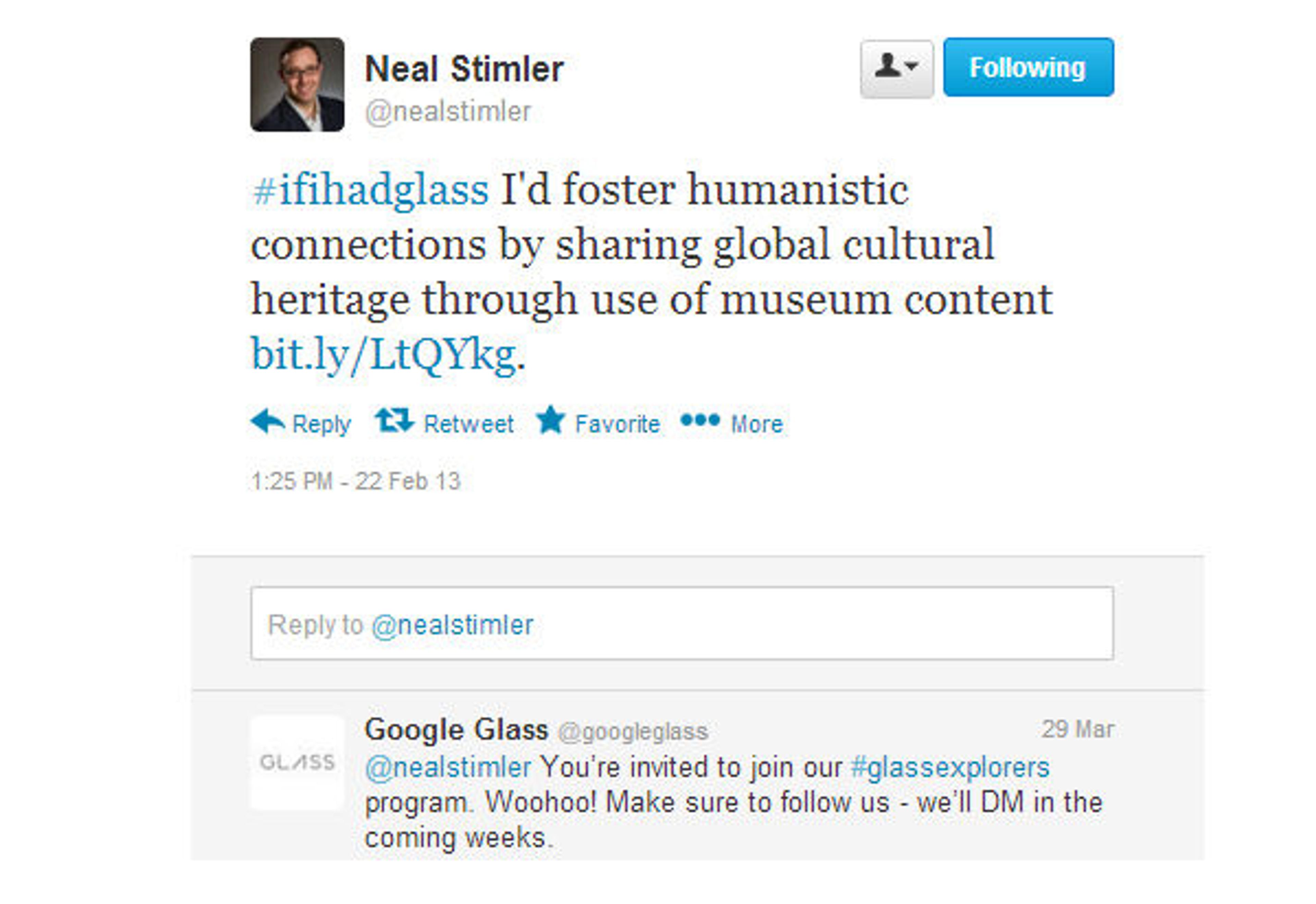Neal Stimler, Twitter post, February 22, 2013, 10:25 a.m., https://twitter.com/nealstimler/status/305020573661155328
«You've probably heard a lot about Google Glass, the mobile wearable technology created by Google that enables users to capture images and video, to receive email, SMS messages, and social media updates, and to find directions or browse the Internet. Although it's arguably the most famous, it's only one of many new mobile devices that has emerged in a field of wearable cameras, smart watches, and wristbands. We can all imagine how to use these devices in our daily lives, but what about inside a museum?»
When I applied to the Google Glass #ifihadglass contest via Twitter and Google+ earlier this year, my intent was to explore the possibilities of how the new technology might serve the missions of museums. In a world interconnected by networked digital information, I believed Google Glass could offer new opportunities for museum visitors to appreciate humanity's shared cultural heritage. Additionally, I thought Google Glass could be a valuable tool to support the daily work of museum staff in terms of community engagement and research. What better place than the Met—with its encyclopedic collection and wide range of visitors—in which to beta test Google Glass?
With the full support of the Museum, I received Google Glass in July 2013 and became one of thousands of worldwide Google Glass Explorers tasked with bringing the product into my community and testing its application in my life and work. In addition to providing feedback to Google, Glass Explorers are encouraged to share their experiences in a forum and on the Glass Explorers Google+ community, as well as on other social media platforms.
From the first moment I put on Google Glass, I had a desire to share what I was experiencing, but I also realized how important it was going to be to listen to others' reactions and absorb their reflections into my own understanding of a museum experience with Google Glass. I'm confident that the way that I will come to know myself, to know the world #throughglass, will be by sharing it with others.
Georgina Goodlander, Twitter post, July 19, 2013, 10:57 a.m., https://twitter.com/bathlander/status/358284478050877441/photo/1; Sara Synder, Twitter post, July 22, 2013, 11:51 a.m, https://twitter.com/sosarasays/status/359385245415514112/photo/1
Studio Museum in Harlem, Instagram post, September 12, 2013 http://instagram.com/p/eNDXZeS52w/
Over the last few months, I've demonstrated Google Glass to colleagues at the Archives of American Art, National Gallery of Art, National Museum of American History, National Portrait Gallery, National Air and Space Museum, Smithsonian American Art Museum, Statens Museum for Kunst in Denmark, Studio Museum in Harlem, and the United States Memorial Holocaust Museum. This initial testing period gave me opportunities to learn the device intimately and to observe first impressions from colleagues in the field. My interest in utilizing Google Glass as a means to improve accessibility to museum content and for onsite experiences led me participate in the Tech@LEAD 2013 conference.
Finished Poster about Google Glass by Joe Azar and Diane Durand of Discovery Doodles, at the Tech@LEAD 2013 Conference. Image, August 20, 2013. http://www.flickr.com/photos/52357995@N07/10088726286. You can read more about the demonstration I did at the Kennedy Center on the Center for the Future of Museums blog.)
Merete Sanderhoff, Twitter post, August 15, 2013, 5:02 a.m., https://twitter.com/MSanderhoff/status/367979545099395072/photo/1; Elissa Frankle, Twitter post, July 22, 2013, 7:31 a.m. https://twitter.com/museums365/status/359319885043625984/photo/1
I look forward to future occasions to share Google Glass with other institutions and colleagues in the field, but now that I've really settled in with this new technology, it's time for focused observation and experimentation with it at the Met. My plan is to conduct exploratory dialogues and tests in collaboration with constituents throughout the Museum, with the goal of understanding Glass's potential utility—and that of any and all wearable technology—within an institution that embodies the breadth of human aesthetic expression. My hope is that we'll uncover new ways to experience cultural resonance and aesthetic wonder—of a life that is united in a digital culture. I'll write about my adventures here in a series of posts, many of which will include images taken with Google Glass at the Met. You can also follow my journey as a Google Glass Explorer at The Metropolitan Museum of Art on Twitter (@nealstimler) and Google+ with the hashtag #metthroughglass.
Links
Glass Explorers Google+ community
Tech@LEAD
Elizabeth Merritt, "Through a (Google) Glass, Darkly," Center For The Future of Museums Blog, August 27, 2013. Accessed October 1, 2013. http://futureofmuseums.blogspot.com/2013/08/through-google-glass-darkly.html
Follow Me
Twitter: @nealstimler
Google+: Neal Stimler
